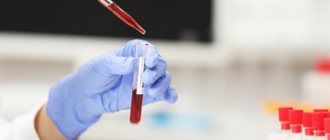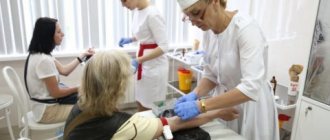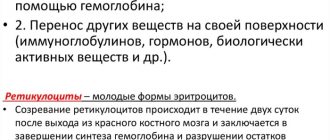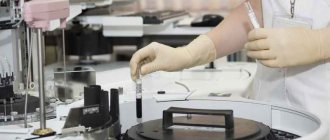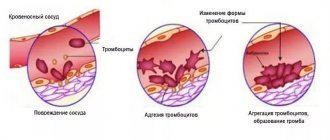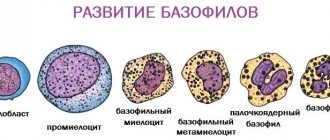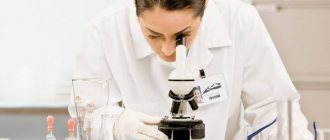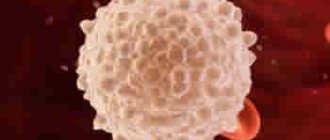Eosinophils
Eosinophils are formed blood cells that are included in the category of leukocytes along with neutrophils and basophils.
They got their name because they can absorb the dye eosin. Their concentration is revealed during a general clinical blood test. This element of the main biological fluid has its own standards, which differ somewhat depending on the age category of the person. Almost always, fluctuations up or down are caused by the occurrence of one or another pathological process.
Any of the disorders does not have specific clinical manifestations - the symptoms will only include manifestations of the basic disorder. It follows from this that a person will not be able to independently determine an increase or decrease in the eosinophil rate.
Any abnormality can be detected only with a general blood test. However, instrumental testing may be required to determine the cause of tolerance problems.
Eosinophils return to normal only when treatment for the provoking pathological condition begins. Therapy can be carried out using both conservative and surgical methods.
Eosinophil test
The eosinophil (eos) blood test determines the percentage of cells out of the total number of white blood cells. This is necessary for the purpose of additional diagnosis of various diseases and timely detection of the inflammatory process, source of infection or parasites. Normally, the concentration of these cells varies throughout the day, depending on the function of the adrenal glands.
In the morning, an increase in cells by 10% of normal is observed. In the late evening and in the first half of the night, the norm is exceeded by 30%.
To get a reliable result, you need proper preparation for the blood test:
- blood is donated in the morning on an empty stomach;
- 24 hours before the test you need to give up smoking, alcohol and sweets;
- women donate blood on days 5-6 of the menstrual cycle.
general characteristics
Eosinophils are a subtype of white blood cells found in human blood and produced by the bone marrow.
The specific features of such substances are:
- the presence of a nucleus, which is divided into 2 lobes;
- ability to stain red under the influence of eosin;
- the ability to go beyond the vascular wall, penetrate and accumulate in foci of the inflammatory process or places where tissue integrity is violated;
- presence in human blood for about one hour, after which they are transported into tissues.
Eosinophils also tend to mature in the bone marrow within 3-4 days, after which they are released into the peripheral bloodstream.
From the bloodstream they move to perivascular tissues, in particular to:
They can remain in such foci for up to 2 weeks.
The main function of such substances is the absorption and dissolution of foreign proteins.
However, they also have abilities such as:
- Increased susceptibility of receptors to class E immunoglobulins. Against this background, antiparasitic immunity is activated, and the cell membranes that surround the pathogenic agent are destroyed.
- Accumulation and stimulation of the release of inflammatory mediators.
- Binding of inflammatory mediators, such as histamine.
- Absorption of small particles by enveloping and drawing them into itself. It is for this reason that eosinophils are often called microphages.
It is noteworthy that during microscopic examination their specific shape is revealed - in appearance they resemble small amoebas.
Since eosinophils in the blood of a child or adult are part of leukocytes, they have the same indicator, and during a general blood test they are designated as WBC.
In the vast majority of cases, eosinophils are found in allergies, but they can also act as markers:
- infectious processes;
- various neoplasms;
- inflammation of the tissues of one or another internal organ;
- parasitic infestation.
What are eosinophilic granulocytes in the blood?
There are 2 main types of white blood cells - granulocytes and agranulocytes. In the first group, basophilic, neutrophilic and eosinophilic cells are distinguished. Each variety performs a specific function. The task of eosinophils is the extracellular destruction of hostile agents that enter the body.
Eosinophils absorb relatively small microbes. This happens by dividing granules inside eosinophils. These cells are able to dissolve the shell of foreign proteins with the help of enzymes.
Eosinophilic granulocytes perform the following functions:
- absorb and then bind substances that provoke inflammation;
- neutralize small pathogenic organisms;
- block the production of histamine by mast cells and basophils in case of allergies;
- activate the body's antiparasitic defenses through the dissolution of their cell membranes by enzymes.
Eosinophils, among other white blood cells, are responsible for protecting the body from pathogens and allergens.
Their normal content is a sign of the well-being of all systems and organs. Increased content is a reason to suspect a problem. Among them are the following conditions:
- diseases of infectious origin at the development stage;
- allergy;
- presence of helminths;
- inflammation.
Normal indicators
When studying the main biological fluid of a person, hematologists always pay attention to such components and count them. In the structure of leukocytes they have an extremely low concentration - 0.5-5%.
The normal blood level may differ slightly by age, but does not depend in any way on gender.
The following table reflects the acceptable indicators:
The norm for women and men is 1-5%. Acceptable values in absolute numbers are 120-350 cells per microliter of blood. Elevated values are called eosinophilia, and low values are called eosinopenia.
Symptoms of increase and decrease
Eosinophils (the norm in women by age depends on the physiological characteristics of her endocrine, digestive, and immune systems) are a subtype of granulocyte-type leukocytes that participate in protecting the body from bacterial, viral, fungal and parasitic invasions.
An increase in the concentration of eosinophils in the blood above the limit of 350 units per 1 microliter of blood serum is classified as a disease of eosinophilia, and is manifested by the following symptoms:
- low-grade body temperature (within 37 degrees Celsius);
- fever;
- intoxication of the body and severe headache;
- red rash on the body;
- itchy skin;
- swelling of epithelial tissues;
- signs of atopic dermatitis.
Depending on what concomitant disease caused a sharp increase in the level of eosinophils in the blood, other symptoms may also occur. In this case, not only general signs of changes in the biochemical composition of the blood appear, but also symptoms characteristic of a specific illness.
A decrease in granulocyte cells below a level of 120 units per 1 microliter of blood is the disease eosinopenia.
Its symptoms can be expressed in the following body conditions:
- physical weakness;
- fast fatiguability;
- drowsiness, loss of strength;
- decreased appetite;
- joint pain, muscle and bone aches.
Most men and women who have eosinophil deficiency in their blood do not experience any symptoms of the disease. This is due to the individual characteristics of the body and the properties of the immune system.
Deviations from the norm
As mentioned above, the rate of eosinophils in the blood of children or adults varies due to the influence of pathological causes.
For example, an increase in the level of such substances can lead to:
- drug intolerance;
- Quincke's edema;
- hives;
- hay fever;
- allergic rhinitis;
- eczema and dermatitis;
- pemphigus and other skin allergic diseases;
- helminthic and parasitic infestations;
- systemic lupus erythematosus;
- fasciitis;
- periarthritis;
- rheumatoid arthritis;
- a wide range of autoimmune diseases;
- tuberculosis and syphilis;
- acute or chronic course of infectious diseases;
- asthma and sarcoidosis;
- alveolitis of a fibrosing nature;
- pleurisy of eosinophilic form;
- Loeffler's syndrome;
- histiocytosis and other pathologies of the lungs;
- malignant diseases of the hematopoietic system;
- gastrointestinal diseases;
- oncopathology.
Elevated eosinophils in infants and children under 3 years of age can be caused by:
- hemolytic disease of newborns;
- Rh conflict with mother;
- pemphigus;
- staphylococcal infection;
- eosinophilic colitis;
- serum sickness;
- atopic dermatitis;
- scarlet fever;
- bronchial asthma;
- chicken pox;
- allergic rhinitis;
- helminthiasis.
The increase in concentration may also be affected by:
- administration of antibiotics;
- failure of the immune system;
- the course of menstruation in women;
- Night time.
It is worth noting that eosinophilia can have 3 degrees of severity:
- light – concentration increases to 10%;
- moderate – the level is 15%;
- pronounced or severe – indicators above 15%.
If eosinophil abs (absolute content) has decreased or is equal to 0, then the reasons for this may be the following:
- severe infectious diseases, which are accompanied by purulent processes;
- pancreatitis;
- inflammatory lesion of the appendix;
- intoxication of the body with heavy metals;
- cholelithiasis;
- pathologies requiring immediate surgical intervention;
- initial stage of development of myocardial infarction;
- painful or infectious shock;
- urolithiasis;
- dysfunction of the adrenal glands;
- diseases of the thyroid gland;
- leukemia;
What the analysis shows
Any deviations in laboratory test results from the norm may indicate pathological phenomena even in the absence of external symptoms. Next, the most likely reasons for a low or high granular cell count will be considered.
What are the causes of decreased eosinophils?
A small percentage of granulocytes (less than 0.7%) or their absence (0%) is observed if a person suffers from the following ailments:
Increased basophils in the blood
- the first day of manifestation of myocardial infarction;
- typhoid fever;
- poisoning from heavy metals, such as thallium, cadmium, arsenic or mercury;
- sepsis;
- Down syndrome;
- appendicitis;
- urolithiasis (formation of stones in the urinary tract);
- severe pain shock;
- pancreatitis;
- acute leukemia (no granular cells);
- diphtheria.
Moderately decreased eosinophils are observed in patients who have undergone surgery. This condition is also typical for premature babies and people with CFS (chronic fatigue syndrome).
Why are leukocytes elevated?
If the analysis results show a lot of eosinophilic cationic protein (more than 10–11%), then there is a possibility of developing:
- rhinitis (runny nose);
- asthma;
- chicken pox;
- pleurisy;
- Quincke's edema;
- eczema;
- sarcoidosis;
- hives;
- tuberculosis;
- systemic lupus erythematosus;
- syphilis;
- bronchial asthma;
- lymphomas;
- hyperthyroidism (increased levels of thyroxine, the thyroid hormone);
- pemphigus;
- rheumatism;
- chlamydia;
- gastritis;
- VSD (vegetative-vascular dystonia);
- hay fever;
- ascariasis;
- vasculitis.
In children under 2–3 years of age, high eosinophils may also indicate the presence of scarlet fever, enterocolitis, HDN (hemolytic disease) and mononucleosis.
Increased granulocytes accompany the formation of foci of malignant tumors, as well as metastases. If the body has previously been exposed to hypothermia, the formed elements of the blood will react in a similar way. For more information about the causes of eosinophilia, see this article.
Sometimes children who are often fed commercial formulas develop an allergy to cow's milk, which is expressed in an increase in the number of eosinophils
Diagnostics
The norm of eosinophils in the blood of women, men and children or its deviations are detected only during a general clinical study of the main biological fluid of a person. Often, material taken from a finger is used for such a study, however, venous blood can also be used.
In order for a hematologist to be able to detect the real content of such substances, the patient is required to follow certain rules.
Preparatory activities include:
- complete refusal to eat on the day of the study, more precisely, no less than 8 hours before visiting the clinic (you are allowed to drink only purified water without gas);
- exclusion of taking any medications - if this is not possible, then you must inform a specialist about this;
- one day before laboratory diagnostics, alcoholic drinks, fatty, spicy and fried foods are removed from the menu;
- on the day of the study, reduce physical activity to a minimum.
Only a hematologist can decipher what a blood test for eosinophils showed, who passes on the information received to the attending physician. However, to identify the causative factor, such a procedure will not be enough, which is why a comprehensive examination of the patient is necessary.
First of all, the clinician must personally carry out several activities:
- review the medical history to look for the underlying illness, which can occur in acute or chronic form;
- collect and analyze life history;
- a thorough physical examination of the patient;
- a detailed survey of the patient or his parents to obtain complete information about the symptomatic picture, which can sometimes indicate to the doctor the underlying illness.
Additionally, other general and detailed laboratory tests, a wide range of instrumental procedures and consultations with specialists from other fields of medicine are prescribed.
Full preparation for the procedure
Very often, laboratory diagnostic results indicate that eosinophils in the blood are low or, conversely, high, due to the patient’s incorrect approach to the upcoming event. Preliminary preparation requires some restrictions in the usual daily routine; the following instructions are of particular importance. Female representatives should not donate blood during the menstrual cycle: it is best to postpone the hematological study for several days.
Regular stay in a state of severe depression and fatigue will certainly affect the key indicators of the analysis, so it is recommended to discuss this problem with your doctor before the procedure. You should forget about increased physical activity for at least 1–2 days, giving preference to calm walking and quiet time.
2-3 days before the procedure, it is necessary to exclude from the diet foods with a high percentage of fat content, spicy and fried foods, confectionery, baked goods, and fast food. Alcohol and coffee are also prohibited. If you regularly use any medications, you need to talk to a specialist about this in advance, since many chemicals affect the composition of the blood. A CBC test for eosinophils is performed on an empty stomach.
Treatment
If eosinophils in a child or adult deviate from the norm or are completely absent, then you need to address the provoking factor as soon as possible. In this case, treatment can be conservative or surgical, but often takes an integrated approach.
Sometimes, to restore the normal eosinophil count in a blood test, it is enough to:
- stop taking medications or replace them with analogues;
- avoid contact with the allergen;
- to refuse from bad habits.
The following can also be used to normalize eosinophils:
- medications prescribed by a doctor;
- diet therapy;
- traditional medicine.
In any case, treatment will be tailored individually for each person.
How to get it back to normal
To bring the level of eosinophils within normal limits, it is necessary to eliminate the main cause that disrupts the biochemical composition of the blood.
Medications
The selection of a drug that helps restore the normal concentration of eosinophils is carried out only by the attending physician or hematologist.
The following means can be used:
- Loratadine - taken 1 tablet per day, and is prescribed if the increase in eosinophil levels is caused by an allergic reaction (therapy period is from 10 to 20 days, and the cost of the drug is 110 rubles);
- Erythromycin is an antibacterial agent that is indicated for use to suppress pathogenic microflora when an increase in eosinophils is an immune reaction to an infectious invasion (take 1-2 tablets 3-4 times a day for 14 days, and the price of the medication is 75 rubles);
- Decaris is an anthelmintic drug that is prescribed if an increase in leukocyte cells is a consequence of infection with parasites (150 mg is taken once, and the price of the drug is 240 rubles);
- Immunal is a complex remedy for restoring the normal functioning of the immune system and leukocyte formula of the blood, which is taken 2.5 ml 3 times a day for 10-14 days, and the cost of the drug is 480 rubles.
Depending on the type of underlying disease causing a decrease or increase in red blood cells, other medications may be used. Before starting a course of drug therapy, it is necessary to establish the cause of the painful state of the body.
Traditional methods
It is not recommended to use decoctions, tinctures, teas prepared on the basis of medicinal herbs, as they do not have the proper therapeutic effect and are not able to affect the decrease or increase in the level of eosinophils in the blood.
Other methods
In combination with drug treatment of eosinopenia and eosinophilia, the following physiotherapeutic techniques aimed at strengthening the immune system can be used :
- contrast shower - taken every morning for 10 minutes;
- dousing with cold water - in the morning or evening every day;
- rubbing with a wet towel is an alternative to dousing or a contrast shower;
- visiting the bathhouse and swimming in the pool - once a week.
All of the above physiotherapeutic methods of restoring normal eosinophil levels must be agreed upon with the attending physician who diagnosed the patient and prescribed medications.
Prevention and prognosis
To prevent the norm from being violated in children or adults, you just need to follow a few simple recommendations, including:
- complete cessation of bad habits;
- complete and balanced nutrition;
- preventing toxic substances from entering the body;
- avoiding the influence of stressful situations and physical fatigue;
- Regularly undergoing a full medical examination.
The prognosis directly depends on the primary source, which led to the fact that eosinophils increased, decreased, or were completely absent. It is worth remembering that each basic disease has a number of its own complications.
source
Eosinophils: age norm in women, table, causes of deviations
Eosinophils are a population of leukocytes, the cells of which act as markers for determining the inflammatory process, infection, allergies, tumors, and parasitic aggression. To determine the concentration of these blood cells, a general blood test is performed.
From the moment the cell appears in the blood, the eosinophil remains in it for about an hour, after which it is sent to the tissues. The main function of the cells is participation in the activation of antiparasitic immunity, the release of inflammatory mediators and the absorption of small particles.
Eosinophil norm, table
The blood test form indicates the number of eosinophils:
- relative – share in the leukocyte formula (in percent);
- absolute - the number of cells per unit volume (v10 9 / l).
The numerical content of eosinophils by age is also expressed in their number per 1 ml. The value of 500 cells/ml corresponds to a value equal to 5*10 9 /l. In the test form, eosinophilic leukocytes are designated by the abbreviation EO - short for eosinophils.
The norms of eosinophils in the blood by age, the same in women and men, are shown in the table.
| Age | EO value (%) | Value (10 9 /l) |
| at birth | 3 | 0.05 to 0.7 |
| first day | 2 | similarly |
| first week | 3,5 | similarly |
| 2 weeks | 3 | similarly |
| 10 – 12 months. | 0.5 to 7 | 0.02 to 0.7 |
| after a year up to 12 years. | from 0.5 to 7 | 0,02 – 0,6 |
| adults, children from 12 years old | from 0.5 to 5 | 0,02 — 0,44 |
In children, the proportion of eosinophils in the leukocyte formula is higher than in adults. This is due to the immaturity of the immune system. In children, there are differences in rates by age. From the age of 12 years, the content of eosinophilic granulocytes in children is the same as in adults.
There are no differences in the norms of this population based on gender. After 50 years, the norm in adults by age increases slightly. Values of 0.02 – 5.5% are considered acceptable.
Indications for the study
Eosinophils (the norm in women by age depends on the individual characteristics of the body) are leukocyte cells, the level of which indicates the possible presence of an inflammatory process, bacterial, viral, fungal or parasitic invasion.
An analysis for the concentration of eosinophils is indicated if the patient has the following symptoms of a painful state of the body:
- fever;
- allergic rhinitis;
- suspicion of helminthiasis;
- periodic increase in body temperature to subfebrile values;
- red rash;
- atopic dermatitis, urticaria, skin itching;
- frequent colds, tendency to infectious and viral diseases.
The study on the concentration of eosinophils in the blood serum lasts from 1 to 3 days in the sterile conditions of a biochemical laboratory. Based on the results of the analysis, a written conclusion is drawn up on the qualitative and quantitative composition of blood cells.
Deviations from the norm
The phenomenon of excess eosinophils in the blood is called eosinophilia. The main reasons for the increase in eosinophils are allergic, autoimmune, and parasitic diseases, as described in detail on the website earlier.
A false increase in test results in the blood is sometimes caused by eosin staining of not only eosinophil granules, but also neutrophils. In such a case, an increase in eosinophils will be accompanied by a decrease in neutrophils.
The number of eosinophilic granulocytes increases at night. In the morning and evening, the content of this population is below the daily average, which is associated with the cyclical functioning of the adrenal glands.
In young women, the cyclicity of changes in the number of eosinophils depends on the phase of the menstrual cycle:
- up to day 15, the number of eosinophils increases under the influence of estrogens to 6–12%;
- in the second half of the cycle, under the influence of the hormone progesterone, the number of eosinophilic leukocytes decreases to normal.
An analysis for eosinophils in peripheral blood is used to assess the condition of the ovaries in women who have not reached menopause by age.
Eosinopenia is a condition in which there is a reduced (less than 0.02 * 10 9 / l) number of eosinophilic leukocytes in the blood.
Eosinophilia
- light – the analysis results are 5 – 10;
- moderate – from 10 to 15;
- heavy – above 15.
The values of pronounced (severe) degree of eosinophilia can reach 60% and higher. High degrees are observed in autoimmune processes - periarteritis nodosa, rheumatoid arthritis, pemphigus.
An excess of eosinophils in the blood can be caused by Dühring's dermatitis, a skin disease that is more common in men than in women. Dühring's herpetomorphic dermatitis manifests itself:
- rashes on the back, inside of the knees, elbows, buttocks;
- itchy erythematous spots.
Young men aged 30-40 years are more likely to develop herpetomorphic dermatitis. Eosinophilic leukocytes with Dühring's dermatitis increase not only in the blood. Significant accumulations of eosinophils are found in blistering rashes on the affected areas of the skin.
Dühring's dermatitis is a paratumoral (tumor-caused) disease, often appearing before the clinical symptoms of the tumor itself, indicating ongoing malignant processes in the body.
If signs of herpetomorphic dermatitis appear, it is necessary to undergo a thorough examination, especially for persons over 65 years of age. Dühring's disease may indicate the development of lung, prostate, breast, and stomach cancer.
Reasons for the increased rate
Excessive levels of eosinophils are called eosinophilia. This condition occurs during inflammation, as a reaction of the body to exogenous stimuli. You should not decipher the analysis yourself. This should be done by a therapist, hematologist or immunologist. Experts distinguish several degrees of violation:
- mild (less than 10%);
- moderate (10 to 15%);
- pronounced (more than 15-20%).
An increase in the level of eosinophils in men, women and children can be provoked by diseases of various origins, irritants that enter the body from the outside - house dust, plant pollen, food products and many others.
Often the cause of eosinophilia is helminthic infestation. If the body is colonized with Giardia, Ascaris, as well as Chlamydia, Toxoplasma, changes in the blood test will appear even earlier than other symptoms of infection. Pumpkin seeds and garlic in the fight against parasites.
In an adult man, woman, or child, the number of granulocytic leukocytes increases when:
- diseases of the bronchopulmonary system;
- manifestations of allergic origin;
- autoimmune disorders;
- acute diseases of an infectious nature;
- malignant neoplasms, oncological diseases of the hematopoietic system.
Some medications can trigger eosinophilia. Among these are drugs from the group of sulfonamides, antibiotics based on penicillin, as well as aminophylline, acetylsalicylic acid, papaverine, diphenhydramine, medications for the treatment of tuberculosis and others.
Indicators of parasitic infection
The number of eosinophilic leukocytes increases during parasitic infections. If the test results reveal an excess of the norm for this population, then both adults and children are prescribed a test for helminth infection.
To independently determine the likelihood of your body being infested with worms, you can assess whether you have to experience similar sensations:
- flatulence, bloating;
- prostration;
- drowsiness;
- abdominal pain;
- depression.
Eosinopenia
Below 0.02 *10 9 /l, the indicators of eosinophilic granulocytes fall in hormonal diseases caused by pathologies of the adrenal glands and thyroid gland. Test results can drop to almost zero in the terminal phase of leukemia.
The following can cause a decrease in analysis results:
- purulent infections, sepsis;
- acute conditions - appendicitis, painful shock, attack of pancreatitis, cholelithiasis;
- heavy metal poisoning;
- long-term stress.
Eosinophils drop to zero on the first day of myocardial infarction. Like neutrophils, eosinophilic granulocytes actively participate in inflammatory reactions, and during a heart attack they rush to the site of damage to the heart muscle.
But, thanks to the stimulating effect of T-lymphocytes, the very next day after a heart attack, the bone marrow compensates for the loss, and eosinophil levels in the blood are restored.
What do low scores mean?
Doctors use various tests to make a diagnosis. As a rule, the examination begins with a general and biochemical blood test. As a result of a type of general test, leukogram, the content of all types of leukocytes in absolute and relative quantities is determined. Eosinophils in the blood are a special type of leukocytes that perform a number of protective functions for the body. Often this test is prescribed to diagnose allergies and determine the presence of parasites.
Looking at the referral form, the patient wonders: what are eosinophils? A type of white blood cell, leukocyte, that responds to the invasion of a foreign protein into the body. They got their name for their ability to absorb the dye eosin, used in laboratory tests.
Eosinophils and the functions they perform are essential to health.
- Absorption and binding of biologically active substances that cause inflammatory processes.
- In the blood, eosinophils activate immunity against various parasites. This destroys the cells and tissues surrounding the parasite and their eggs. Other types of leukocytes respond to the process of cell destruction, absorbing parasitic cells and eliminating their toxic effects.
- Absorbs various small particles.
Acceptable standards
In women and men, the norm of eosinophils in the blood is the same, and in children the absolute number of leukocytes changes with age. In a general blood test, the indicator may be designated “eos” or “eo” from the word Eosinophils. Divide the absolute value, which is the number of cells per liter of blood. Measured in billions or 10⁹/l. In a blood test, the general indicator may not be the only one.
The relative count is the percentage of eosinophils out of the total white blood cell count.
The normal percentage level is 1–5% in adults and children of all ages.
What are eosinophils in blood tests? The absolute indicator depends on the age category. In children from birth and in the first 5 years of life, eosinophils are normally 0.02–0.7 × 10⁹/l. By age 10, the white blood cell count drops to 0.6×10⁹/l. From the age of 21, the “adult” indicator is established and eosinophils in a blood test in a healthy person are no more than 0.45 × 10⁹/l.
Age Normal limits
| up to 5 years | 0.02–0.7×10⁹/l |
| 5 – 10 years | up to 0.6×10⁹/l |
| adults | up to 0.45×10⁹/l |
During pregnancy, women often experience a decrease in eosinophil levels. After childbirth, they are practically gone; the number of leukocytes can drop to zero. Within a few weeks the indicators return to normal. If the leukocyte level has not returned to normal, additional examination should be performed.
If an allergic reaction is suspected, a blood test for eosinophils and eosinophil cationic protein (ECP) is performed. This figure increases with the development of dermatitis, allergic rhinitis and food allergies. Also, the protein level or protein reflects the effectiveness of the treatment. To carry out the analysis, laboratories use a hematology analyzer.
Elevated eosinophils in a blood sample are termed eosinophilia. This phenomenon reflects inflammatory processes in the body and the reaction to external stimuli. The analysis is interpreted by a hematologist. Usually there are 3 degrees of eosinophilia.
- Less than 10% mild form
- 10 to 15% moderate eosinophilia
- Above 15% pronounced form
We recommend: What does MSHC show in a blood test?
In some cases, for a pronounced stage it is necessary to exceed the norm by 20% or more. Eosinophil levels are affected by many diseases and irritants.
Even the familiar allergic rhinitis causes an increase in the number of white blood cells.
As a rule, the norm for eosinophils in the blood is the same for all adults, but in case of chronic diseases, the doctor interprets the analysis taking into account the influence of the disease.
- Skin lesions (dermatitis, lichen, etc.)
- Autoimmune diseases (lupus erythematosus, etc.)
- Infection with parasites (worms, lamblia, roundworms, etc.)
- Diseases of the gastrointestinal tract in the chronic stage
- Severe allergic reaction (rhinitis, hay fever, etc.)
- Magnesium deficiency
- Consequence of taking certain medications (antibiotics, aspirin, etc.)
- Acute infectious diseases (tuberculosis, gonorrhea, etc.)
- Malignant large tumors that are accompanied by tissue necrosis
- In heart disease, a high level of eosinophils may indicate the development of myocardial infarction
When the eosinophil count is too low, a condition occurs that may be referred to as eosinopenia. What it is? This is a drop in the absolute level of eosinophils below 0.2 × 10⁹/L. This condition can be caused by various factors.
- Pain shock
- Severe purulent infections, sepsis
- Disorders of the thyroid gland and adrenal glands
- Leukemia (possible drop to zero)
- Myocardial infarction (on the first day)
- Toxic effects on the body due to poisoning with heavy metals (arsenic, lead, etc.)
- Inflammation of appendicitis and other processes requiring surgical intervention
- Long-term stress
The number of eosinophils in the blood and leukocytes of other types reflects the patient’s immune status, since these cells are responsible for protecting the body from various pathogens. A blood test helps identify the presence of allergies, parasites or inflammatory processes. Other diseases can be determined by the level of leukocytes.
krov.expert
What are eosinophils in a blood test? Since these blood cells are classified as leukocytes, eosinophils in a blood test are counted as a percentage of the total number of leukocytes. They are usually designated EOS or EO.
The norm of eosinophils in men and women does not differ significantly, but the age of the patient plays an important role. In children from birth to one year, the rates range from 1 to 6%; by the age of two, the upper limit increases slightly (to 7%), and then by the age of 18 it decreases to 5%, as in adults.
The number of eosinophils is not a constant value; under the influence of various factors, it can change during the day. These indicators are influenced by the work of the adrenal glands (especially during sleep). The highest percentage of these cells is observed after midnight to mid-night, with a 20% decrease occurring during the morning and evening hours. In this regard, it is most rational to take a blood test for eosinophils in the morning, otherwise the indicators will not be objective.
If the transcript of the analysis shows an increased number of eosinophils, then you need to look for the cause of this pathology.
Among its possible options are:
- allergies;
- specific reaction to the drug;
- problems with the gastrointestinal tract that are chronic;
- skin pathologies (eczema, dermatitis, etc.);
- lack of magnesium in the body;
- parasite infection;
- oncological diseases;
- heart defect (congenital);
- cirrhosis of the liver.
If a general blood test for eosinophils shows high numbers during an infectious disease, this is a positive sign. As the body fights an infection, eosinophils also rise slightly, but this is a sign that the disease is receding.
It happens that tests show low eosinophils.
This is the first sign of exhaustion of the body due to various reasons:
- stress;
- injuries;
- pathologies of bone marrow;
- burns;
- infection (initial stage of the disease);
- blood poisoning.
When a patient takes anticancer drugs, it creates a problem for the bone marrow. It cannot form white blood cells, so the concentration of eosinophils decreases. This also happens when the body experiences physical stress.
In the postoperative period, testing for eosinophils also shows their low level. However, this indicator alone cannot help accurately determine a specific disease, so in this case a full examination is necessary.
If monitoring of inflammatory processes in the body is necessary, the doctor will prescribe an analysis for eosinophilic cationic protein. This is a protein that is very important for assessing the condition of the body in the presence of diseases based on inflammation. It shows how active eosinophils are during an inflammatory response.
The concentration of eosinophilic cationic protein allows us to assess the severity of allergic skin diseases.
A blood test for eosinophils is an important component in the diagnosis of serious diseases.
Changes in leukocyte formula
Representatives of different populations of leukocytes interact with each other during immune, inflammatory, and autoimmune processes. This means that with an increase or decrease in the number of eosinophils, the need for other populations of leukocytes - lymphocytes, monocytes, neutrophils, basophils - also changes.
Eosinophils are higher than normal for age and elevated monocytes are observed in viral and fungal infections, sarcoidosis, mononucleosis, gonorrhea, and tuberculosis infection.
Exceeding the norm of eosinophils and lymphocytes by age is observed in allergies caused by infection with parasites, in dermatoses of an allergic nature, and scarlet fever. Indicators of eosinophilic granulocytes and lymphocytes increase during treatment with antibiotics and sulfonamides.
source
Functions of eosinophils in the body
Eosinophils are a type of granulocytic leukocytes in the blood serum that play an important role in maintaining the stable functioning of the body’s immune system, as well as its response to parasitic invasions in the gastrointestinal tract.
Eosinophils got their name due to their properties for staining using the Romanovsky method. When their surface is exposed to the dye eosin, which has an acidic composition, they change color and, in relation to other blood cells, are separated into a separate fraction.
Eosinophils are synthesized by bone marrow cells.
Each such leukocyte body contains 2 oblong nuclei of the bilobed type. A distinctive feature of eosinophils is that they are able to go beyond the blood vessels and penetrate into the tissues of internal organs.
This property is due to the functional purpose of granulocytic cells, as well as their role in the immune response to the penetration of parasite larvae, bacterial microorganisms, and chemical compounds of toxic etiology into the human body.
According to the latest scientific research data, eosinophils perform the following functions in the human body:
- have phagocytosis, absorbing harmful bacteria, protozoan viruses and fungal microorganisms (the greatest effectiveness of granulocytic cells is manifested against streptococci, gonococci, pneumococci, staphylococci, meningococci);
- act as an irritant for Fc class receptors of the immune system, which stimulate the production of antibodies necessary to fight parasites (this function of eosinophils is triggered after eggs and larvae of helminths, as well as other organisms leading parasitic Lifestyle);
- reduce the level of inflammation, promote more accelerated restoration of damaged tissues, reduce regeneration processes;
- in the event of local inflammation in soft tissues or internal organs, as well as in the event of mechanical damage, eosinophils, along with the blood flow, are directed to the site of pathology and take part in a complex immune response, preventing infection with a bacterial infection;
- have the function of binding and absorbing histamine, preventing an acute allergic reaction of the body at the moment when its receptors encounter potential allergens (household dust, dampness, mold, pollen of plants and fruit trees, animal hair, some types of food);
- takes part in regulating the balance of beneficial and pathogenic intestinal microflora, neutralizing pathogenic microorganisms;
- are an indicator of infectious infection of the body or chronic inflammation, which occurs latently and is practically asymptomatic (this is evidenced by a sharp increase or decrease in the level of eosinophils, which depends on the type of disease).
Eosinophil levels in men and women vary by age and reflect the overall health of the immune system.
Despite the fact that eosinophils are considered to be classical phagocytes that absorb pathogenic bacteria, the main functional purpose of granulocytic leukocytes is to form antiparasitic intestinal immunity. In the mucous membrane and submucosal layer of the gastrointestinal tract, their concentration is 300 times higher than in blood serum.
Eosinophils in the blood: what is the norm and what are the causes of deviations
Eosinophils are a type of white blood cell that is constantly produced in the bone marrow. They mature over 3-4 days, after which they circulate in the blood for several hours and move to the tissues of the lungs, skin and gastrointestinal tract.
A change in the number of these cells is called a shift in the leukocyte formula, and may indicate a number of disorders in the body. Let's look at what eosinophils are in blood tests, why they can be higher or lower than normal, what diseases this shows and what it means for the body if they are elevated or lower.
How and under what conditions is it produced?
Eosinophils, a type of granulocytic leukocyte, are produced by bone marrow tissue. The percentage of these cells increases if the human body experiences an acute allergic reaction, a bacterial, viral, fungal infection or parasite infestation has occurred.
In the absence of negative influence of external and internal factors, the level of eosinophils is maintained within normal limits without a sharp increase or decrease. Once in the blood, granulocyte cells remain in the serum for no more than 12 hours, and then penetrate into the organs of the digestive system, where they accumulate. It can remain in the tissues of internal organs for up to 12 days, providing an anti-inflammatory and antibacterial effect.
Normal levels in children and adult men and women
The main function of eosinophils is the destruction of foreign proteins that enter the body. They penetrate into the focus of the pathological process, activate the production of protective antibodies, and also bind and absorb parasitic cells.
The norms of such particles in the blood are determined by a general analysis, and depend on the time of day, as well as the age of the patient . In the morning, evening and night, their number may increase due to changes in the functioning of the adrenal glands.
The role of eosinophils in the body
These blood cells are a type of leukocyte, therefore, like all leukocytes, they perform a protective function, protecting the body from foreign harmful elements. Their granules contain enzymes that are powerful parasite destroyers. They are especially sensitive to bacteria and can eliminate the consequences of the actions of lymphocytes and neutrophils to cleanse the body.
These cells are able to control the release of histamine, which is a major factor in the development of the allergic condition. Thus, they “smooth out” a strong reaction to a foreign protein.
Eosinophils have a peculiarity: they move to the site of infection even through the walls of blood vessels and tissues. That is, they can be found both in the blood and in the tissues.
Another important function of these blood cells is the ability to prevent the formation of blood clots (they prevent platelets from sticking together).
In general, they bring great benefits to the body:
- They bind, dissolve and absorb foreign protein.
- Protect the body from allergens.
- Accelerate the healing process of wounds.
- Eliminate inflammation.
- Slows down the growth of cancer cells.
What does it mean if the indicator is elevated?
A shift in the leukocyte formula with a high level of eosinophils (eosinophilia) indicates that an inflammatory process is occurring in the body .
A severe degree is considered a fairly dangerous condition for humans , since in this case there is often damage to internal organs due to oxygen starvation of tissues.
When diagnosing cardiovascular diseases
In itself, an increase in eosinophils in the blood cannot indicate damage to the heart or vascular system , but pathologies, the symptom of which is an increase in the number of this type of leukocytes, can cause cardiovascular diseases.
The fact is that in the place of their accumulation, inflammatory changes are formed over time, destroying cells and tissues . For example, long-term, severe allergic reactions and bronchial asthma can cause eosinophilic myocarditis, a rare myocardial disease that develops due to exposure to eosinophil proteins.
Main reasons for the increase
Excess eosinophil counts can have a number of different causes including:
- damage to the body by parasites: helminthic infestations, giardiasis, ascariasis, toxoplasmosis, chlamydia;
- acute allergic reactions and conditions (allergic rhinitis, urticaria, Quincke's edema, dermatitis of various etiologies);
- pulmonary diseases: bronchial asthma, sarcoidosis, pleurisy, fibrosing alveolitis;
- autoimmune pathologies, which include systemic lupus erythematosus, rheumatoid arthritis, periarteritis nodosa;
- acute infectious diseases or exacerbations of chronic ones (gonorrhea, tuberculosis, infectious mononucleosis);
- oncological diseases, including malignant blood tumors - for example, lymphogranulomatosis;
- taking certain medications - aspirin, diphenhydramine, papaverine, aminophylline, sulfonamides, anti-tuberculosis drugs, penicillin antibiotics, etc.
Eosinophils in a complete blood count (EO)
Eosinophils are included in the list of indicators of the leukocyte formula; their norm is 1-5%.
They play a major role in the neutralization and destruction of foreign cells (parasites, protists, bacteria) circulating in the blood and located in tissues. This happens by producing special receptors that bind to immunoglobulin-E to form a cytotoxic (cell-destroying) complex. EO activation occurs both independently and after the absorption of mediators released by basophils. Due to the large accumulation of IgE in the area of concentration of eosinophils, an allergic reaction such as anaphylactic shock may develop.
EO activation occurs both independently and after the absorption of mediators released by basophils. Due to the large accumulation of IgE in the area of concentration of eosinophils, an allergic reaction such as anaphylactic shock may develop.
Considering the main functions of the SW, an increase in their number can be observed when:
Recovery from an infectious-inflammatory process is a favorable sign;
Parasitic invasion of the body;
Activation of various allergic reactions, including those occurring in a chronic form (bronchial asthma, dermatitis, hay fever);
Autoimmune systemic diseases;
Malignant lesions of the red bone marrow (leukemia), lymphoid tissue (lymphoma);
Metastatic tumors of internal organs (especially with metastases to the lungs and bones).
Eosinophils decrease in the case of:
Immunosuppression (cytostatics, glucocorticoid hormones);
Use of antiallergic drugs;
Bone marrow devastation;
The patient's serious condition.
In the absence of any pathological symptoms leading to a change in the number of eosinophils in the general analysis, it is necessary to perform this study at least once a year for preventive purposes.
Reduced content in the results of the general analysis
A decrease in the level of eosinophils in the patient’s blood (eosinopenia) is no less dangerous than their increase. It also indicates the presence of an infection , pathological process or tissue damage in the body, as a result of which protective cells rush to the source of danger and their number in the blood drops sharply.
What does it mean for diseases of the heart and blood vessels?
The most common reason for a decrease in eosinophils in the blood in heart disease is the onset of acute myocardial infarction . On the first day, the number of eosinophils may decrease until they completely disappear, after which, as the heart muscle regenerates, the concentration begins to increase.
What causes the decrease
Low eosinophil counts are observed in the following cases:
- severe purulent infections and sepsis - in this case, the leukocyte form shifts towards the young forms of leukocytes;
- in the first stages of inflammatory processes and in pathologies requiring surgical intervention: pancreatitis, appendicitis, exacerbation of cholelithiasis;
- severe infectious and painful shocks, as a result of which blood cells stick together into mud-like formations that settle inside the vessels;
- dysfunction of the thyroid gland and adrenal glands;
- poisoning with lead, mercury, arsenic, copper and other heavy metals;
- chronic emotional stress;
- advanced stage of leukemia, when the concentration of eosinophils can drop to zero.
Indications
The simplest, most convenient and reliable way to determine the number of eosinophils is a general blood test. This study is mandatory for all patients, regardless of the disease, in outpatient clinics and hospitals.
First of all, calculating the level of eosinophils in the blood is necessary if the following diseases are suspected:
- Rheumatoid arthritis.
- Bronchial asthma.
- Tumors of the hematopoietic system (lymphogranulomatosis, lymphoma, leukemia).
- Immunodeficiencies.
- Parasitic infestations.
In addition, allergic reactions are indications for the study.
Increased normal eosinophil levels
In hematology, a condition in which eosinophils are elevated in an adult or a child is referred to as eosinophilia. This condition in itself is not a disease, but acts as a kind of marker of pathological changes in the body. There are three forms of eosinophilia:
- mild – the eosinophil count does not exceed 10 percent;
- moderate – up to 15 percent;
- pronounced - more than 15 percent.
At the same time, a number of hematologists expand the border of moderate eosinophilia to 20 percent, and expressed, accordingly, according to this gradation, starts from 21 percent. There is also a confirmed correlation between the form of eosinophilia and the complexity of the pathological process, which led to the growth of eosinophils in the blood: a higher degree of eosinophilia in most cases characterizes the complex course of the pathological process.
The reasons for the increased level of this type of leukocytes can be a number of reasons:
- atopic diseases (bronchial asthma, allergic rhinitis, hay fever);
- parasitic diseases (malaria, ascariasis, giardiasis);
- non-atopic skin diseases (pemphigus, dermatitis, epidermolysis);
- gastrointestinal diseases (gastritis, ulcers, cirrhosis of the liver);
- rheumatic diseases;
- hematological diseases (leukemia, anemia, polycythemia, lymphogranulomatosis, eosinophilic leukemia);
- lung diseases (pneumonia);
- weakened immune system;
- allergic reactions of all kinds. They are considered the most common cause of increased eosinophils in the blood;
- side effects from taking medications (most often eosinophilia is provoked by banal aspirin and a number of antibiotics in the form of injections).
